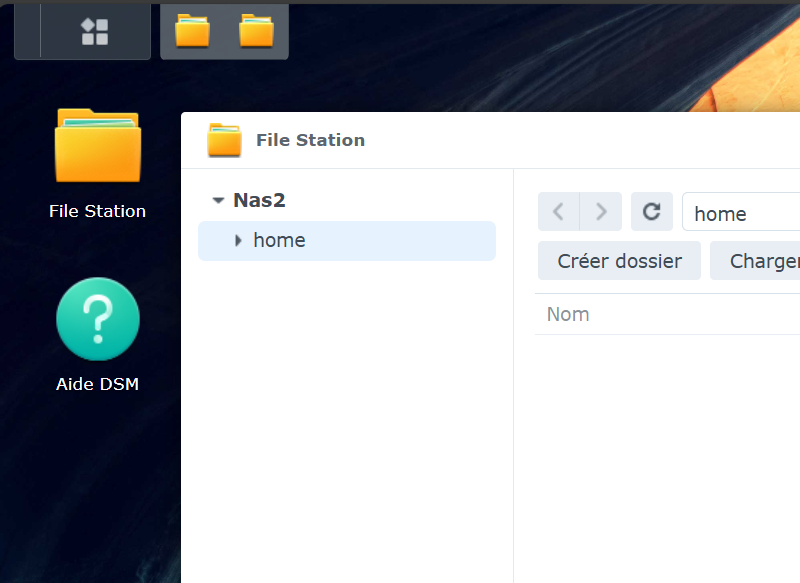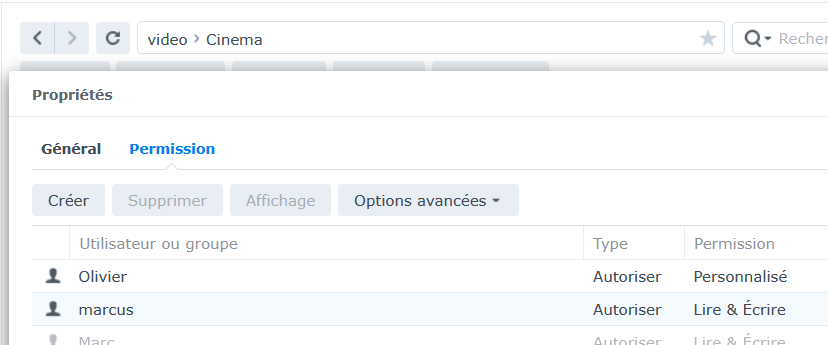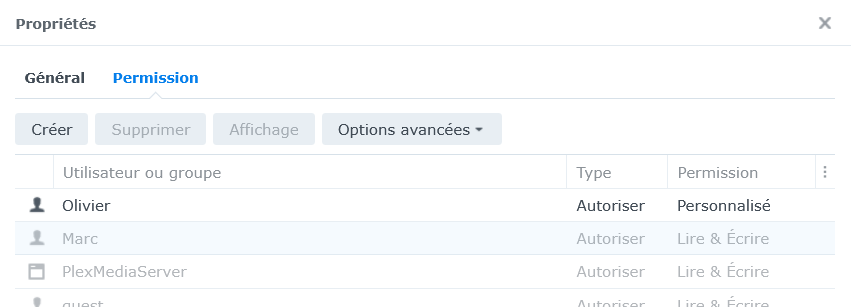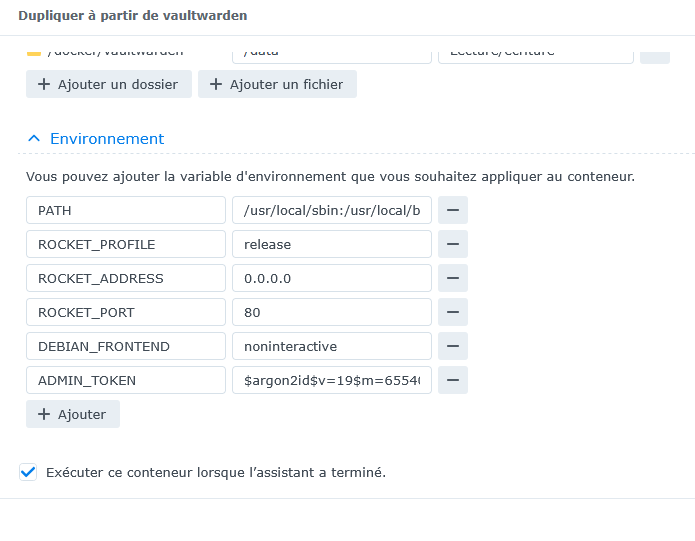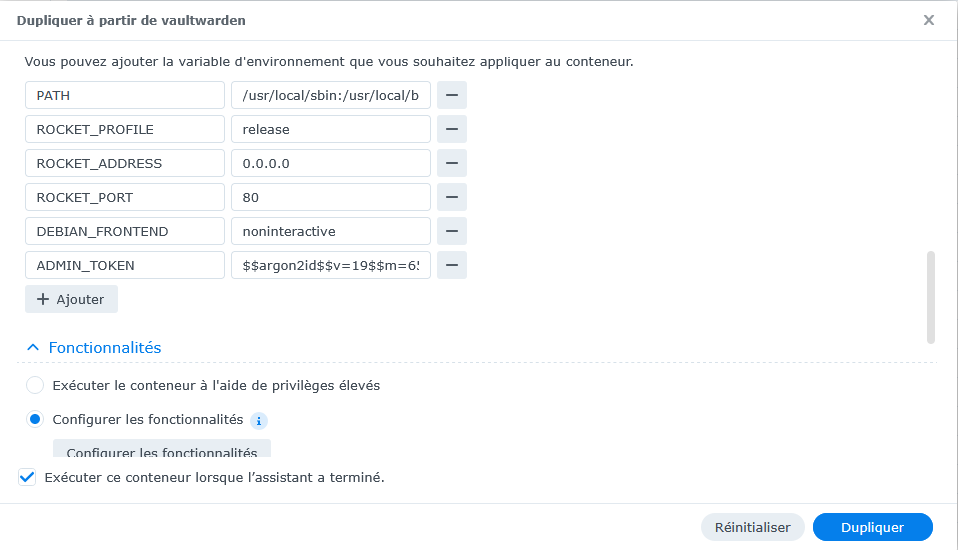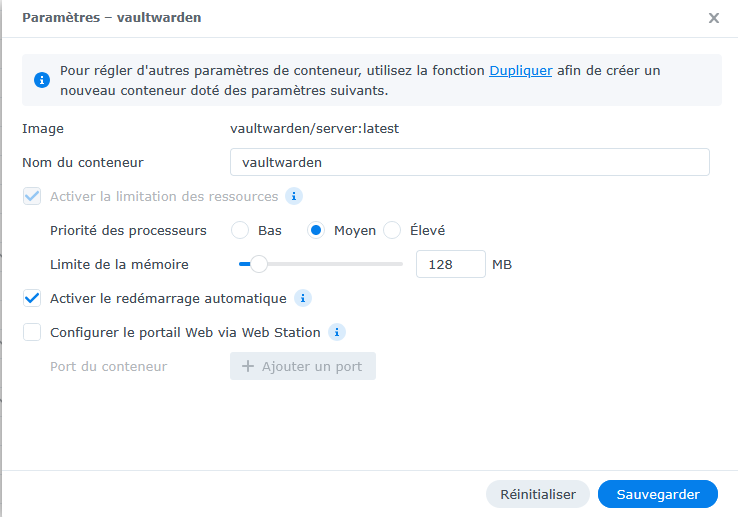-
Partager des répertoires
Salut, Excellent ! c'est parfait ! Merci
-
Partager des répertoires
Bonsoir, Je viens de regarder une nouvelle fois le tuto, je trouve l'exemple assez différent : il parle de différencier les utilisateurs d'un groupe sur un répertoire partagé "cabinet X" Moi, j'aimerais partager un sous répertoire sur un répertoire qui n'est pas partagé pour cet utilisateur. Je n'ai pas trouvé comment faire. Et si c'est une usine à gaz, je préfère laisser tomber et me débrouiller autrement.
-
Partager des répertoires
Je n'ai rien changé à ce que j'avais… donc rien de plus à dire
-
Partager des répertoires
OK Merci, vous pouvez clôturer
-
Partager des répertoires
"Vidéo" est un répertoire partagé, et "Cinema" est un sous-répertoire. Je ne veux pas donner accès à vidéo, car il y a des vidéos perso, contrairement à cinéma. Si j'ai bien compris, c'est normal. La seule solution consiste à envoyer un lien de partage sur ce répertoire
-
Partager des répertoires
Bonjour, Je n'ai pas trouvé solution à mon problème. Pour avancer, j'ai créé un compte test pour essayer sans déranger le copain. Par défaut, je n'ai activé aucun répertoire partagé, il a accès à home uniquement. j'ai ajouté dans les permissions d'un répertoire "Cinema" l'utilisateur "test" L'accès à "cinéma" n'apparaît pas sur le compte "test" Je suis débutant, peut-être est-ce un fonctionnement normal...
-
[Résolu]Accès extérieur page web
Avec l'aide de chat GPT j'ai construit une première page index qui renvoie vers les répertoires secondaires. Finalement, c'était la meilleure solution.
-
-
[Résolu]Accès extérieur page web
Bonjour. J'ai installé webstation et j'ai mis dans un répertoire des pages web. Pour y accéder de l'extérieur, je mets monnom.myds.me et j'y accède sans difficulté. J'aurais aimé y accéder en mettant par exemple panorama.monnom.myds.me Si je tape : n'importequoi.monnom.myds.me ça me ramène toujours à la même page web. Est-ce qu'il serait possible d'accéder à ces pages avec un proxy inversé en mettant par exemple panorama.monnom.myds.me pour une page de panorama ? Ou est-ce que l'on est obligé de mettre monnom.myds.me/panorama pour accéder à panorama ou autre chose ? Merci
-
Partager des répertoires
Bonjour, J'ai créé un compte pour un copain Olivier, j'ai créé un répertoire partagé à son nom sur lequel il a les droits de lecture et d'écriture. Lorsqu'il se connecte, il y accède sans problème. Je voulais lui partager un autre répertoire à moi, où il y a des photos et des films. J'ai été dans les propriétés de ce répertoire et j'ai ajouté dans les permissions son nom. Néanmoins, lorsqu'il se connecte sur son compte, il ne voit pas apparaître ce répertoire. Qu'est-ce que j'ai loupé ? Merci
-
[Résolu]VaultWarden Activation de la page d'administration
-
[Résolu]VaultWarden Activation de la page d'administration
Ce n'est pas la version la plus simple qu'on puisse trouver 😗 Ça va m'emmener dans des installations que je ne maîtrise pas. Je n'ai plus portainer par exemple. La partie qui m'intéresse est traitée avec le renvoi vers le lien que j'ai cité au début... # Pour activer la console d'administration, accessible via : https://mon.domaine.tld/admin/ # Voir détails ici : https://github.com/dani-garcia/vaultwarden/wiki/Enabling-admin-page # /!\ # /!\ N'importe qui pourra accéder à la page de connexion, alors blinder le token d'amdin ci-dessous (64 caractères pour moi) ! # /!\ Il est de plus TRÈS important d'avoir ACTIVÉ le HTTPS avant l'activation de cette option. # /!\ # Je conseille de ne l'activer qu'en cas de nécessité, et de la désactiver après. # L'utilisation d'Argon2 est recommandée, voir ici : https://github.com/dani-garcia/vaultwarden/wiki/Enabling-admin-page#secure-the-admin_token # Pour désactiver, il suffit de commenter la ligne ci-dessous. ADMIN_TOKEN=XXxxXX De toute façon, la console d'administration n'est pas ce qu'il y a de plus important pour moi. Je n'aurai deux ou trois comptes au maximum. Même si ce n'est pas fait proprement, je peux accéder à l'interface d'admin et la désactiver après.
-
[Résolu]VaultWarden Activation de la page d'administration
Bonjour, Oui j'ai suivi le tuto d'it connect : https://www.it-connect.fr/auto-hebergement-installer-vaultwarden-bitwarden-sur-son-nas-synology/ C'est pour la version de base sans traiter de la partie administration...
-
[Résolu]VaultWarden Activation de la page d'administration
Bonjour, j'ai installé vaultwarden dans un conteneur, il fonctionne très bien J'essaie d'activer correctement la page d'administration. https://github.com/dani-garcia/vaultwarden/wiki/Enabling-admin-page#secure-the-admin_token Pour y avoir accès, il faut insérer une variable d'environnement ADMIN_TOKEN = un token du genre : bXBGMENBZUVzT3VUSFErTzQzK25Jck1BN2Z0amFuWjdSdVlIQVZqYzAzY Après avoir mis le token, ça fonctionne. Ils expliquent dans la DOC qu'il faut sécuriser le token ce qui permet finalement d'entrer non pas le token en tant que mot de passe, mais le mot de passe qui a généré ce token. j'ai généré mon token Argon2 : du genre : $$argon2id$$v=19$$m=19456,t=2,p=1$$UUZxK1FZMkZoRHFQRlVrT.... J'ai arrêté mon conteneur, j'ai édité les paramètres et j'ai remplacé le champ ADMIN_TOKEN le nouveau token Argon 2 il ne semble pas être prise correctement en compte... Pour accéder à l'interface d'administration, je colle le token complet de $$argon2... : Je n'arrive pas à mettre le mot de passe à la place du token. J'ai toujours le message d'erreur qui me dit que le token n'est pas sécurisé Je n'arrive pas à trouver la bêtise ou la chose que je ne fais pas.
-
Changer paramètres conteneur -> fonction dupliquer ?
Ok C'est fait... finalement ce n'est pas trop compliqué.
-
Changer paramètres conteneur -> fonction dupliquer ?
Bonjour, J'ai installé vaultwarden dans un conteneur docker sur mon NAS. Ça fonctionne très bien. J'aurais voulu rajouter des paramètres pour accéder à la console d'administration. J'ai arrêté le conteneur, quand j'ai fait Action -> Paramètres j'ai un message qui me dit que je dois utiliser la fonction dupliquer afin de créer un nouveau container doté des paramètres suivants... J'avoue que je suis un petit peu décontenancé et perdu par cette proposition.
Information importante
Nous avons placé des cookies sur votre appareil pour aider à améliorer ce site. Vous pouvez choisir d’ajuster vos paramètres de cookie, sinon nous supposerons que vous êtes d’accord pour continuer.



